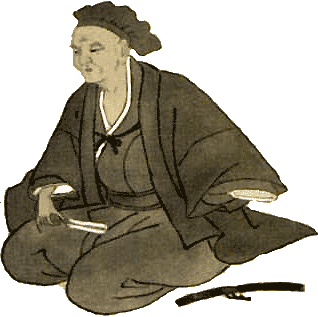Why Murata Juko is said to be the founder of Wabicha
Image of Murata Juko – Public Domain by Wikimedia
Part of practicing the Japanese tea ceremony is to learn its history. The name Murata Juko (村田珠光 1422 – 1503) comes up first as a person we should remember. That he introduced the “wabi” concept to the tea ceremony.
“Wabi” is becoming quite popular even among non-Japanese-speaking people. Often combined with “Sabi”, the word represents something simple, rustic, and profound, a distinct characteristic of Japanese culture.
What happened to tea ceremony as a gamble, you may ask. Well, there is a slight remnant of tea gambling in the practice today. Chakabuki 茶歌舞伎, it’s called. And in the procedure, you try to guess which tea is the same one as you had before. There is no betting, however. We only practice the procedure to further deepen our experience of tea.
When Juko was alive, tea as gambling still existed, practiced among high-ranking aristocrats and samurai. How come Juko didn’t follow that trend? Why did he choose to pursue “wabi”cha? Why his direction had a significant influence on the development of tea ceremony in later years?
I haven’t found any clear answer to this question, so I can only do some research on my own.
Juko was born in Nara. At the age of 11 he was sent to a Buddhist temple. He was there until 20 years old, but for a while after that, it is unknown where exactly he lived and what he was doing
A document that was written years later says he taught then Shogun Ashikaga Yoshimasa tea ceremony, but recent studies deny it. But it’s likely he spent some time in Kyoto.
During the Onin no Ran (応仁の乱 1467 – 1477), Juko is said to have gone back to Nara and lived in a humble hut serving tea.
The following is my speculation.
Onin no Ran is a civil war that lasted as long as 11 years. This civil war started as a dispute over who would become the next shogun.
Historians still debate today why it involved so many samurai and why it had to last that long. One monk who lived in that era wrote in his diary, “No matter how hard I try, I still don’t understand why this horrible war had to happen.”
During the war, so many temples, shrines, and palaces in Kyoto, including Daitokuji, where Shuko is believed to have practiced Zen under Ikkyu, a famous master, were burnt to the ground.
When people in Kyoto say “the last war,” they often refer to Onin no Ran, not World War II. That’s how horrible the collective memory of this war was. Buildings were razed. Lives were ruined. The war affected every class of people.
Sitting in the tearoom, people might have contemplated their own dire circumstances and how fragile their lives were, instead of partying and gambling. In my opinion, Onin no Ran’s impact on people’s mindset towards the practice of tea was profound. Juko was no exception, in my guess.
One of the very few historical traces of Juko is a record kept by Daitoku-ji Temple. In memory of the thirteenth anniversary of his Zen master Ikkyu’s death, Juko contributed money for the rebuilding of Daitoku-ji in 1493.
